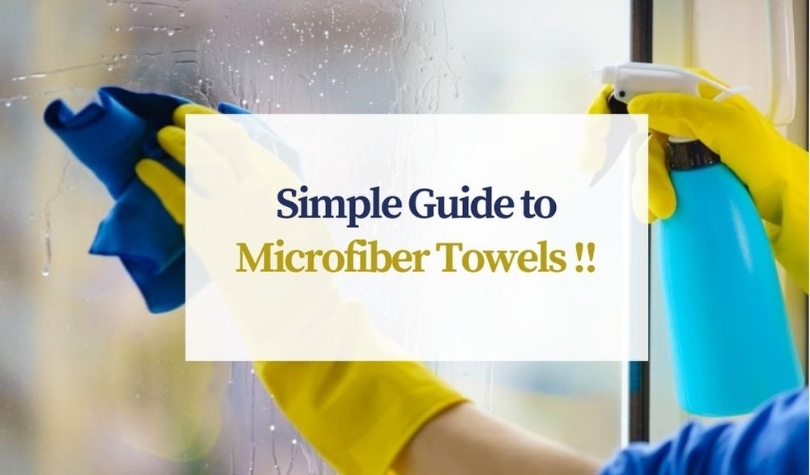Most of you have already heard about the magical microfiber cleaning cloth. That tiny fiber has already imprinted a significant impact in the cleaning Industry.
This guide will enlighten your knowledge about how the small thread holds ample space in the cleaning process.
What is Microfiber?
Microfiber is a low-denier synthetic fiber made up of Polyester, Polyamide, and Polypropylene blending. The fact that "towels made up of synthetic fiber" will amaze you and make you question their absorbency. Blending Polyester with Polyamide increases the absorbency of the microfiber.
The fantastic factor about microfiber is the "Diameter of the fiber," which is lesser than the human hair strand and silk fiber. Now you can imagine that how microfiber is finer and tinier than other fibers.
How Microfiber Towels Manufactured?
As we already told that microfiber is a combination 80:20 ratios of polyester and polyamide, respectively. After melting these synthetics, the filament extruded to the required length. For increasing the absorbency, extruded fibers split up into n number of parts. Eventually, n number of threads weaved in a loop to make a Microfiber Cleaning Cloth.
"Splitting" is the crucial difference between microfiber towels and cotton towels. Splitting traps the water and dust from the nook and corner of the surface. Unlike Cotton Towels, microfiber towels absorb the dust and moisture from the surface without pushing them around.
Key Beneficiary Features of Microfiber:
The primary beneficiary features of Microfiber towels are,
- High Absorbent
- Streak-free
- Lint-Free
- Captures dust
- Pierce into the tiny corner spaces
- Light Weight & Strong fiber
Microfiber towels would be the top choice for commercial cleaning and domestic cleaning purposes with tons of beneficiary features. You could use the microfiber cloth for almost all of the cleaning tasks. It's okay to replace cotton and paper towels for good.
Types of Microfiber Towels:
Various types of Microfiber towels are available in the market. The crucial task is finding the good towels to suit your cleaning process.
Before classifying towels, we have to acquaint the terms "GSM" and "Pile."
GSM: Gram per Square Meter: GSM denotes the density of Towels. It's measured by the number of fiber strands composed in a square meter.
Pile: It's a heap of strands (Visible), and each stack contains thousands of fibers which tightly woven together.
1) General use Towels:
- It has a Short pile & 220GSM
- 80/20 Polyester and Polyamide Blending Ratio
- Used to clean car interiors, doors, and windows
2) Safe Cleaning Towels:
- It has a Medium pile & 360 GSM
- 75/25 Polyester and Polyamide Blending Ratio
- It's suitable for cleaning all surfaces and used for polishing and car waxing
3) Safer Towels:
- Medium Pile & 400 GSM
- 75/25 Polyester and Polyamide Blending Ratio
- Safer to clean Glasses and wheels
4) Delicate Towels:
- Long Pile & 600 GSM
- 70/30 Polyester and Polyamide Blending Ratio
- It is used to clean delicate surfaces
5) Waffle Weave Towels:
- Short Pile & 300-500 GSM
- Waffle Weaves – Honeycomb fabric. Threads are rectangular in shape.
- Good for drying glasses
6) Chenille – Microfiber Towels:
- Fabric extended to some extent to hold the dust
- It's in mitts
- Used to wash surfaces with shampoo
Checklist for purchasing Microfiber Towels:
It's essential to ensure a few features of Microfiber towels before purchasing them.
GSM Rating: GSM is one of the essential ratings to determine the quality of towels. GSM is related to the density/weight of towels. If the GSM rating is higher, the Towels are plushier, denser, softer, and costlier. Towels of GSM range 200-300 and are suitable for general cleaning tasks. But it leaves streak marks on the surfaces. Towels with a GSM rating of 600-700 are perfect for wiping delicate surfaces without scratching.
High GSM rating towels are durable due to the tight composition of fibers. You choose to procure towels that meet your requirements at affordable prices.
It's another critical factor in determining the absorption level of the towels. Generally, microfiber towels are made up of synthetic fibers such as polyester, polyamide, and polypropylene. For the commercial cleaning towels, polyester and polyamide are combined in a 70/20 or 70/30 ratio, respectively.
As we know, polyester resists water penetration but adding polyamide in a particular ratio will increase the absorbency of the towels. Towels with a blending ratio of 70/20 and 70/30 would be the most acceptable option for cleaning and drying the surfaces.
Split count defines the absorbency of the fibers. A fiber with more segments absorbs water more than three times its weight. 16 split/fiber would be the ideal choice for drying spaces. In addition, check the woven type of the towel with the split count. The microfiber strand woven in the loop is better at trapping debris and water than the fiber in the flat weave.
How to care for Microfiber Towels?
Microfibers bear both machine wash and manual wash. Following the two simple rules is easy to care for microfiber towels.
- Avoid Fabric softener
- Avoid heat drying
Heat & Fabric softeners are the main enemies that deteriorate fabric strength.
Simple Guidelines to enhance the longevity of Microfiber Towels:
- Wash microfiber towels in warm water.
- Heavy Alkaline Products affect the softness of the fabric. To avoid that, use less amount of detergent.
- Avoid fabric softener. It affects the absorbency of the fiber.
- Wash Microfibers separately. Microfibers attract lint when mixed with cotton clothes and towels.
- Do not wash dark color towels with light color towels.
- Do dry towels under warm sunlight. If you choose a dryer, dry them with low heat settings. High heat breaks the fiber.
- It is better to prefer air drying.
- Store dried towels properly in the closet to avoid cross-contamination.
If we care for towels properly, they will withstand more than 30 washes. Stick with guidelines to maintain the towels in good condition. Poor quality of towels causes damage to the surfaces to clean.
We hope this guide will be helpful in purchasing and handling microfiber cleaning Towels.
Do not hesitate to share your thoughts and suggestions in the comments!!






